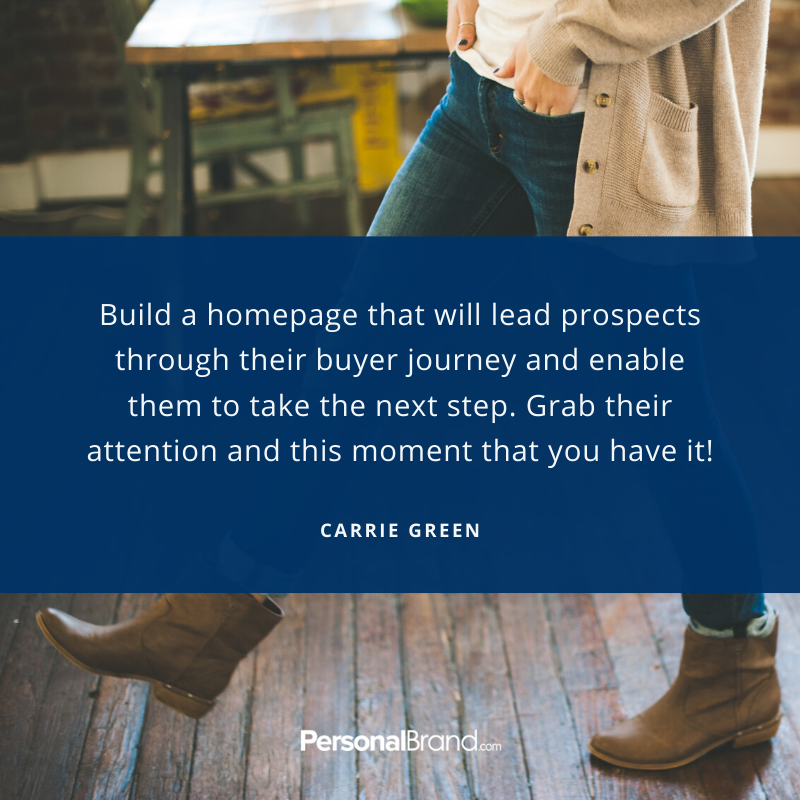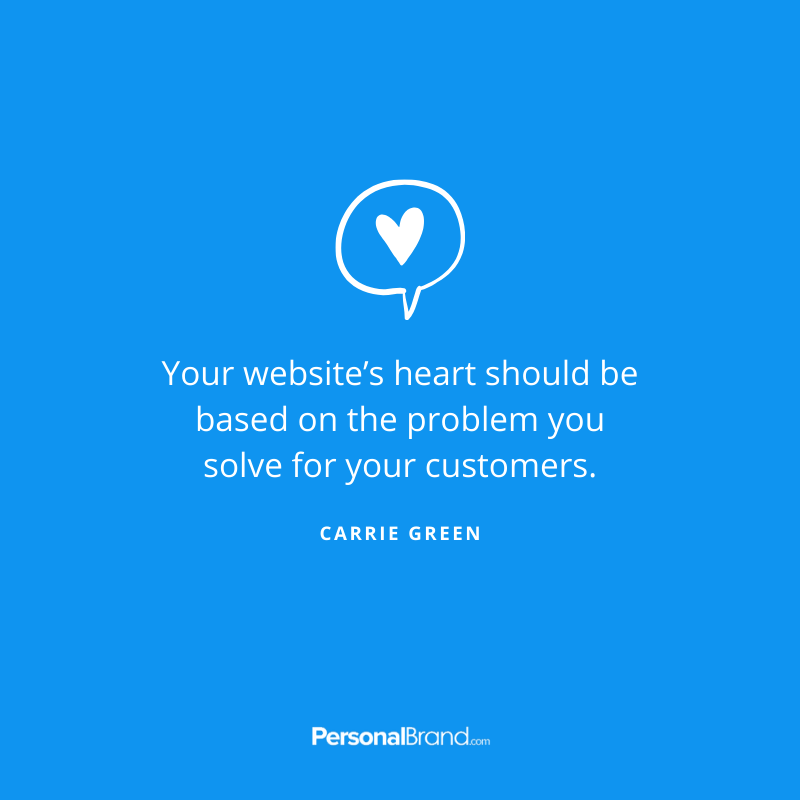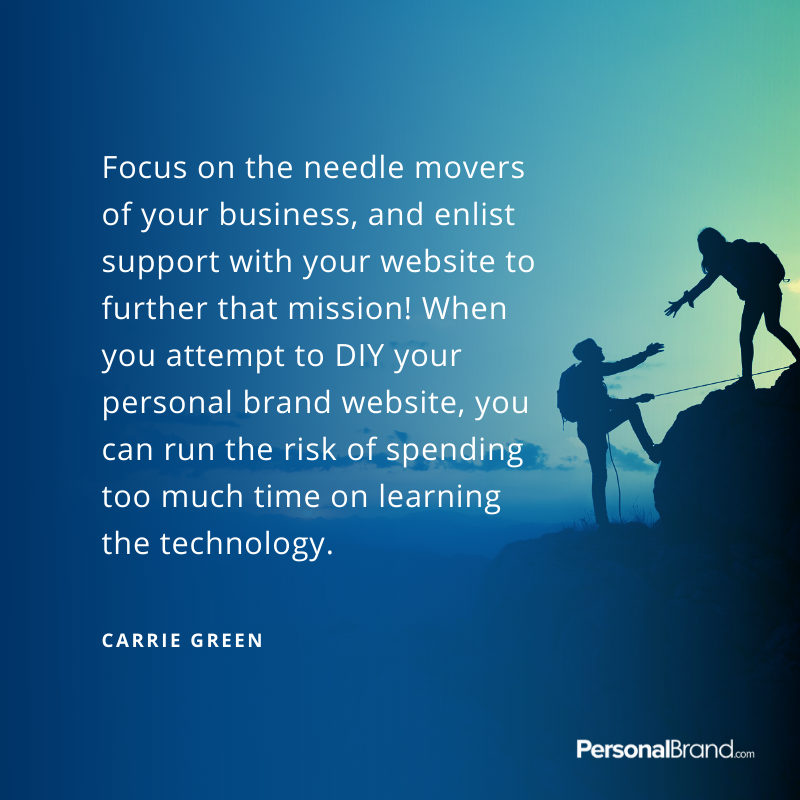The 6 Mistakes to Avoid When Building Your Personal Brand Website
Your personal brand website should serve as the foundation of your digital presence and should help prospective customers and followers learn about you, your philosophy, your offering, and ultimately make a purchase.
When thinking about your personal brand website, know that the days of sites acting as online brochures are pretty much gone.
Your website needs to be interactive, dynamic, and engaging.
Most importantly, your website’s heart should be based on the problem you solve for your customers. It should address your customer’s journey by including content for every phase of the buyer’s cycle and should align fully with your marketing strategy.
For the past eight years, I’ve had the pleasure of working with industry leaders, entrepreneurs, and innovators to design their personal brand websites. I can tell you that there are six critical mistakes that people too often make during this process.
Now I’m sharing what I’ve learned so you can avoid these common pitfalls and design a digital presence that will help you achieve your goals and future-proof your marketing efforts.
Mistake # 1: Not Designing the Homepage to Speak to the Customer Journey
There are three phrases to any customer journey:
- Awareness Stage. Your prospect is experiencing a problem, challenge, or issue and is just starting to learn what options may be available to solve that problem.
- Consideration Stage. Your prospect is researching all options available to solve his problem, which includes your direct and indirect competitors.
- Decision Stage. Your prospect has decided which avenue he will pursue to solve his problem, and is researching you and your direct competitors to choose a partner.
What this means relative to the design of your personal brand website, is that your homepage needs to address these three phases by communicating who you are, your value proposition, and what sets you apart from the competition, making you their best choice as a partner.
Avoid making your homepage a photo gallery of your recent social media posts or your bio.
Build a homepage that will lead prospects through their buyer journey and enable them to take the next step. This may mean making a mental note of your personal brand, contacting you for an initial meeting, or making a purchase.
Mistake # 2: Managing Your Website on Your Own
In the early days of building your personal brand, you may have had the bandwidth to design and update your website as needed, but as you grow and scale your business, you’ll need help.
It’s critical for search engine optimization (SEO) and marketing efficiency to keep your website up-to-date and current with your latest news, offerings, public appearances, videos, testimonials, and other engaging and motivating content.
When you attempt to DIY your personal brand website, you can run the risk of spending too much time trying to teach yourself how to create and manage content, and use new digital tools. That’s time that you could spend on running your business instead. When DIYing your website, you also run the risk of not having something function correctly, such as an opt-in form, which hurts sales conversions.
It may seem tempting to save money by managing your website using one of the new content management systems that claim to be easy for non-technical users, but know that these tools are not as simplistic as they try to appear. Also, with website builders, unless you have chosen a reliable, high-speed hosting company, your website’s performance may be clunky, which will hurt, rather than help, your online credibility.
To avoid these challenges, as a busy entrepreneur, you’ll want to hire someone to help you manage your website.
Make sure you hire a professional who understands the unique challenges of personal branding and can be a long-term strategic partner on which you can rely. As entrepreneurs, we all try to wear so many hats that our attention becomes divided. Work with a professional to come up with a strategy and content plan.
This person may not be the same team member who designs and programs your website. However, it should be someone who can write and produce content for you so that you can focus on serving your customers.
Click here for six questions to ask before you hire anyone to build your personal brand website.
If your budget is a significant concern that’s holding you back from hiring a quality designer and building a high-quality website, then click here to learn how to build a personal brand website on a budget.
Mistake # 3: Not Optimizing Your Website for SEO if Organic Traffic is a Critical Part of Your Marketing Strategy
If your strategy for obtaining website traffic includes banking on Google search and organic traffic, then SEO matters. Doubtless, other forms of traffic to your website matter, too, such as social media, inbound marketing, email marketing, personal networking, and client referrals.
When it comes to filling your pipeline with prospects in the consideration phase, SEO helps.
Eighty-seven percent of shoppers begin their product and service research online. This data indicates that whether you offer marketing and business consulting, training, self-help guidance, coaching, software as a service, or anything else, you’ll want your website keyword optimized and designed to follow search engine best practices.
With an optimized site, you’ll increase your odds of appearing on the first page of Google search results—where 91 percent of users will click after conducting their search.
SEO strategies evolve rapidly, and at pace with changes to Google’s search algorithm, which means unless you are an SEO expert, you’ll want to work with someone who can prove he/she maintains current knowledge of web design and SEO best practices.
Mistake # 4: Worrying Too Much About the Website Being “Pretty”
Sometimes people make the mistake of putting too much time into making their website “pretty.” They focus on fancy design elements like videos, transitions, and unexpected navigation.
The quality of a website’s design should be determined based on how well it functions, not its aesthetics.
Such functionality includes how well it converts prospects into sales, how visitors flow through the website, reviewing engaging content and moving through the customer journey, and its ease of use. While everyone wants a beautifully designed website, the real priority should be how well the website functions in helping you to meet your goals.
One area of your website’s design where you do want to ensure high-quality imagery, however, is photography. Your photos will do more to ensure prospects perceive you and your personal brand as authentic than any color palette or unique design element that you can dream up.
Mistake # 5: Not Focusing on Clear Messaging
Clarity and messaging can make or break a website.
The copy you write for your personal brand website is critical. Words matter. Rather than overthinking it or trying to be too clever, clearly state what problem you solve for your customers, how you solve it, and then include the steps a prospect can take to get there.
For example, if you are an executive-level coach, clearly communicate that you help business leaders reach their full potential, and prospects should start their career improvement journey by signing up for your five-week course. It’s that easy.
Click here for more tips on creating your value proposition, which should serve as the foundation of your website’s communication strategy.
Mistake # 6: Not Using Calls to Action
Every page of your website needs a call-to-action to keep visitors engaged, moving further into your website’s content and their buyer journey until they are ready to make a purchase. Use strong copywriting that calls your prospects to action to book a call or request more information.
This strategy will allow you to pre-qualify your prospects and also understand their needs first.
Click here for more insights on creating effective calls-to-action.
Final Advice: Learn from the Best
If you’re ready to enhance your personal brand website, get inspired by some of the industry’s leaders.
I recommend drawing inspiration from digital marketing entrepreneur Neil Patel. Also, Stu McLaren, the former co-founder of WishList Member, one of the world’s largest membership platforms, has done an inspiring job designing a personal brand website that showcases how to create a website that reflects your marketing strategy. His Tribe Workshop website immediately draws visitors in and encourages them to learn about his offering and sign up to take part.
For even more inspiration, here are six more examples of the world’s best personal brand websites.
We hope you enjoyed this article, thanks for reading! Also, follow us on Facebook, and Twitter for updates every time we publish!





